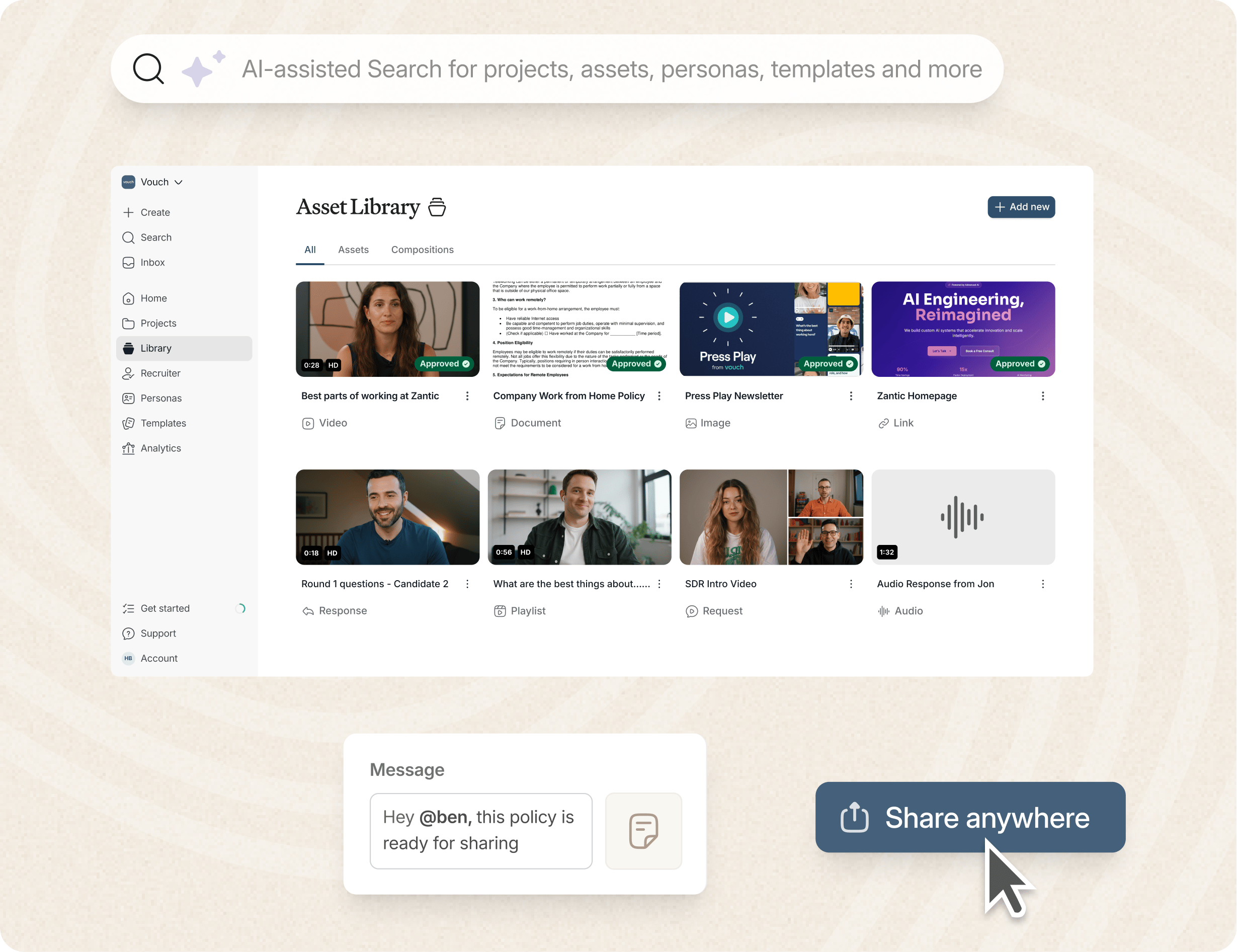Internal communication goals are specific, measurable objectives that are designed to enhance employee engagement, streamline information flow, and build a better workplace culture.
However, as every company is unique, setting your own internal communications goals is key.
And this is where a few frameworks can help, including the SMART framework that is extremely popular in companies of all shapes and sizes.
There are also tools like Vouch that can significantly help with your team's internal communications goals.
So, with that in mind, let's dive into setting up - and tracking your internal communications goals.
Why Set Internal Communication Goals?
Setting internal communication goals is crucial for several reasons. Here are the main goals for internal comms teams:
- Enhances Employee Engagement: Clear internal communication goals help ensure employees are informed, engaged, and feel a sense of belonging and commitment.
- Improves Information Flow: Well-defined internal communication goals streamline the flow of information, reducing misunderstandings and ensuring everyone is on the same page.
- Boosts Productivity: Effective communication minimizes errors and redundancies, leading to more efficient and productive workflows.
- Strengthens Company Culture: Clear internal communication goals promote a positive and cohesive workplace culture.
- Supports Change Management: Goals provide a framework for communicating changes effectively, helping employees adapt more quickly.
- Increases Employee Morale: When employees feel informed and involved, their morale and job satisfaction are likely to improve.
- Facilitates Feedback: Setting goals encourages two-way communication, allowing for valuable employee feedback and insights.
- Aligns with Organizational Objectives: Internal communication goals ensure that messaging aligns with the company's strategic objectives, keeping everyone focused on common goals.
What Are SMART Internal Communications?
SMART internal communication goals are specific, measurable, achievable, relevant, and time-bound objectives that help guide and improve the effectiveness of communication.
Some of the world's best companies use the SMART framework.
Here's what SMART stands for, as well as an outline of the framework using a company newsletter as an example. This company newsletter could be an internal communications channel, such as your intranet, emails, and even in-person communications:
S - Specific
Clearly define what you want to achieve with your internal communication efforts. For example: "Increase employee engagement with the company newsletter."
M - Measurable
Establish criteria for measuring progress toward achieving the goal. For example: "Boost the open rate of the company newsletter from 40% to 60%."
A - Achievable
Ensure the goal is realistic and attainable given the resources and constraints. For example: "Implement a feedback system to collect suggestions from employees on newsletter content."
R - Relevant
Align the goal with broader organizational objectives and ensure it addresses key communication needs. For example: "Improve communication about company-wide initiatives to enhance understanding and participation."
T- Time-bound
Set a clear deadline for achieving the goal to maintain focus and urgency. For example: "Achieve a 20% increase in newsletter open rates within the next six months."
By leveraging SMART internal communication goals, you can create a structured and effective approach to improving internal communication while helping their employees become more engaged with their company and culture.
The AI-enabled workspace for talent teams.
- Unified workspace for talent teams
- Accelerate hiring with AI tools
- Auto-generate polished hiring and employer brand content
- Easily repurpose assets across all channel

What Are Good Internal Communication Goals? (And Some Poor Ones)
When you're setting your internal communication goals, it's key to know the difference between ones that will help and those that won't.
Let's look at what makes some goals that are better than others:
Good internal communication goals include:
- Align with what your business wants to achieve overall.
- Encourages employees and how people see your company and leaders.
- Are clear-cut: specific, measurable, achievable, relevant, and have a deadline (SMART).
- Improve employee engagement and motivation.
- Boosts your bottom line.
On the flip side, poor internal communication goals will lead to:
- They are too broad or fuzzy, making them tough to implement or measure.
- Don't address the internal communication goals your employees face on a daily basis.
- Don't help improve your company's overall success.
What Are The Top 7 Tools for Effective Internal Communications?
Discover the top 7 tools for effective internal communications: email, Project Management Systems, Forums, Messaging Systems, Social Media, and more.
These essential communication tools enhance employee engagement and productivity.
1. Your Company Email
During the 1980s and 1990s, email became common place in businesses, government, universities, and the defence industries.
Today, email is one of the most widely used internal communication methods and one that everyone understands - and no surprise on this list.
Email was designed for both one-to-one communications, and company-wide messaging.
The best part of email for your internal communications goals is that you can measure open rates and engagement metrics so you can continually improve your communication efforts.
Utilizing email as a communication tool can be highly effective, as it allows for the creation of different audience segments for your internal emails and the ability to tailor content to them. Additionally, incorporating other internal communication tools such as apps, software, and platforms can further streamline and enhance your communication efforts.
2. Internal Videos
Whether on an email, intranet, or other platform, video tools like Vouch can drastically improve your internal communications goals.
This Forbes article found that viewers retain 95% of a message when they watch it in a video, compared to 10% when reading it in text.
The reason the video is so effective is that employees will stop to engage with your videos and almost feel like they are taking a little break over reading yet another email or text-based internal comms media.
3. Your Intranet And Knowledge Base Software
Knowledge-based software and intranets play a pivotal role in enhancing internal communications within organizations. By centralizing information, you can ensure that employees have access to accurate and up-to-date data at their fingertips.
With any intranet or similar system, even an LMS, utilizing features like search functionality is vital, as many intranets quickly get overwhelming. With whatever intranet system you use, you need to be sure there's a consistent flow of information across different employees and departments and work on transparency and diversity.
4. Project Management Systems
To boost internal communications goals, leveraging project management systems like Asana or Trello, teams can streamline collaboration, track progress, and enhance overall efficiency.
These systems facilitate task delegation, set clear deadlines, and provide a centralized hub for projects.
The challenge is that PM systems are often silos across teams, which is the purpose of these tools, but often not a company-wide communications strategy and different teams might need different project management systems. For example, your software developers will need a more comprehensive tool for managing new products, whereas your marketing team likely loves Trello or a more simplified system that does not require too much management.
5. Internal Forums
Internal forums, often attached to your internal Wiki or Intranet, are really handy for sparking conversations and collaborations within your company - and lots of large companies use internal forums or post boards to post internal videos or questions for the wider teams.
With forums, different groups or departments within your company can come together, and on top of that, forums act like a big library of info where employees can easily find what they need or catch up on the latest news about the company. Just be sure to have a forum moderator to keep the messages on track and encourage open communication between frontline employees and business leaders.
6. Internal Messaging Systems
When we talk about internal communication goals, we can't look past tools like Slack, which have changed the ways internal teams collaborate.
With these platforms, you can quickly share news, get people working together better, and help everyone feel like they're part of a big family at work.
These tools can also replace more traditional forums. By bringing these kinds of tools into your internal communications, everyone in your company can collaborate, which helps your entire organization.
7. Social Media
When thinking about your internal communication goals, social media can really help get employees involved while helping you grow your employer brand. Social media platforms can help when it comes to sharing news about the company, celebrating successes together, and building a community feeling among staff.
If you are using your company's social media for employee advocacy, be sure to implement the right social media policies. You can find more on that here: Employee Advocacy on Social Media.
FAQs
What are the goals of internal corporate communication?
The goals are to align everyone with the business objectives, boost employee engagement, and ensure clear communication with key stakeholders. Clear internal communication goals help companies achieve significant business success.
What are the 5 goals of communication?
The main goals are to share information, persuade, educate, prompt action, and build connections. Clear communication ensures people understand and work well together towards common objectives.
What are Internal Communication Goals Depending On?
These goals vary based on company size and current circumstances. Smaller companies may focus on unity and engagement, while larger companies might emphasize understanding and following main goals. Targets should align with each organization's specific needs and challenges.
What key metrics related to employee communications do you want to track?
Track metrics like employee engagement rates, response times, feedback frequency, and participation in company initiatives to measure the effectiveness of internal communications.
How do internal communications goals contribute to employee engagement?
Clear communication goals foster transparency and alignment, boosting collaboration, morale, and productivity. When employees understand objectives and feel valued, they are more engaged in achieving shared success.
How can internal communications goals align with overall company objectives?
By aligning internal communication strategies with company goals, internal communications can significantly contribute to organizational success. Setting targets that match company objectives helps drive progress and reach key goals.
Conclusion
Having clear internal communications goals is vital for every single employee.
To help, think of setting SMART goals, which means your targets should be Specific, Measurable, Achievable, Relevant, and Time-Bound. These kinds of goals help teams work better together because everyone knows what's going on and feels more connected.
To ensure your internal communication messages are effective, be sure to also survey your employees with tools like Vouch to track and analyze your SMART strategy and efforts.
Transform Your Internal Communications With Vouch!
Loved by companies like Canva, Nike, Cisco, HubSpot, Amazon, and more, tools like Vouch make leveraging video in your business remarkably easy.
Be sure to book a Vouch demo today and chat with a video content expert.
You might also like

Elevate Your Brand Today With Vouch
Discover how Vouch can accelerate talent acquisition while helping you stay on-brand.






